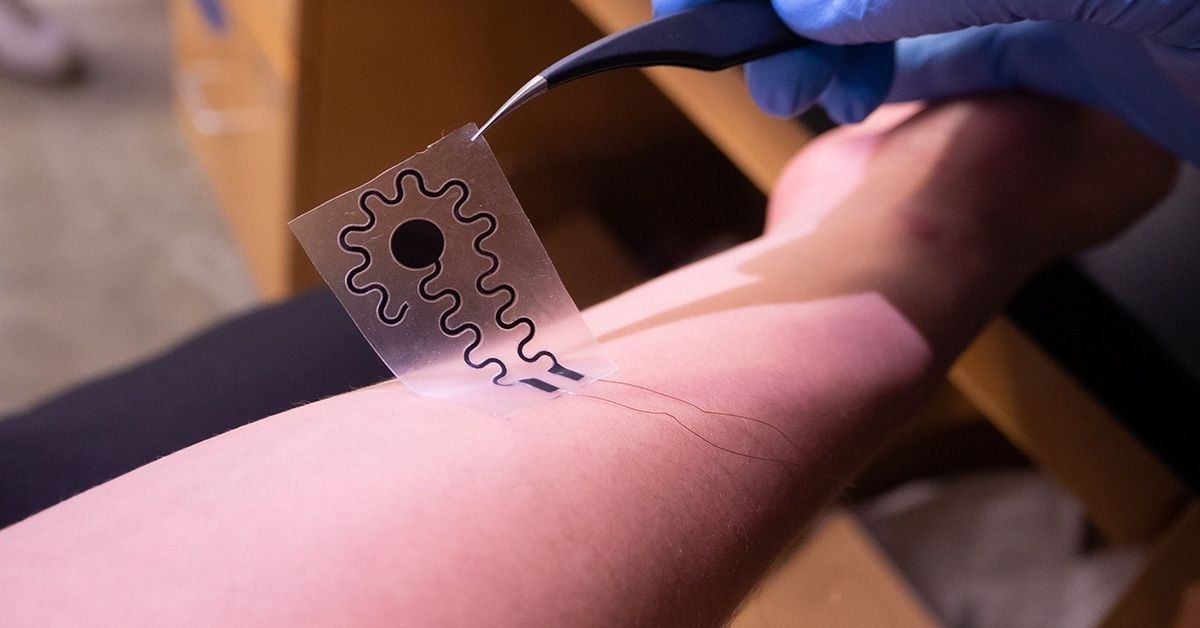A group of scientists at the University of California, San Diego, have created a flexible, pliable electronic gadget that, when applied to the skin, can mimic the sensation of pressure or vibration. This gadget, described in the journal Science Robotics, is a step toward developing haptic technologies that can replicate a wider variety of realistic touch sensations.
 Soft, stretchable electrode recreates sensations of vibration or pressure on the skin through electrical stimulation. Image Credit: Liezel Labios/UC San Diego Jacobs School of Engineering
Soft, stretchable electrode recreates sensations of vibration or pressure on the skin through electrical stimulation. Image Credit: Liezel Labios/UC San Diego Jacobs School of Engineering
A silicone patch is fastened to a pliable, supple electrode to form the device. It can be applied to the fingertip or forearm like a sticker. The electrode is wired to an external power source and is in direct contact with the skin. Depending on the signal's frequency, the device can induce vibrations or pressure sensations through the skin by passing a small electrical current through it.
Our goal is to create a wearable system that can deliver a wide gamut of touch sensations using electrical signals—without causing pain for the wearer.
Rachel Blau, Study Co-First Author Postdoctoral Researcher, Jacobs School of Engineering, University of California, San Diego
Current technologies that use electrical stimulation to mimic touch frequently cause pain because they use stiff metal electrodes that do not fit the skin well. Painful electrical currents may arise from the air spaces between these electrodes and the skin.
Blau and a group of scientists, under the direction of Darren Lipomi, a Professor in the UC San Diego Aiiso Yufeng Li Family Department of Chemical and Nano Engineering, created a soft, flexible electrode that easily conforms to the skin to solve these problems.
Made from the building blocks of two existing polymers—a soft, stretchy polymer called PPEGMEA and a conductive, rigid polymer called PEDOT:PSS—the electrode is composed of a new polymer material.
Blau said, “By optimizing the ratio of these [polymer building blocks], we molecularly engineered a material that is both conductive and stretchable.”
The polymer electrode is affixed to a silicone substrate after being laser-cut into a spring-like, concentric design.
This design enhances the electrode’s stretchability and ensures that the electrical current targets a specific location on the skin, thus providing localized stimulation to prevent any pain.
Abdulhameed Abdal, Ph.D. Student and Study Co-First Author, Department of Mechanical and Aerospace Engineering, University of California, San Diego
Undergraduate students Yi Qie, Anthony Navarro, and Jason Chin from UC San Diego's nanoengineering department collaborated with Abdal and Blau on the synthesis and fabrication of the electrode.
Around 10 participants wore the electrode device on their forearms during the tests. The University of Amsterdam's behavioral scientists and psychologists worked with the researchers to determine the lowest detectable electrical current level. The electrical stimulation's frequency was then changed, enabling participants to feel pressure or vibration-related sensations.
We found that by increasing the frequency, participants felt more vibration rather than pressure. This is interesting because biophysically, it was never known exactly how current is perceived by the skin.
Abdulhameed Abdal, Ph.D. Student and Study Co-First Author, Department of Mechanical and Aerospace Engineering, University of California, San Diego
The new discoveries may make the creation of sophisticated haptic devices for use in wearable technology, medical prosthetics, and virtual reality possible.
This work was supported by the National Science Foundation Disability and Rehabilitation Engineering program (CBET-2223566). It was performed in part at the San Diego Nanotechnology Infrastructure (SDNI) at UC San Diego, a member of the National Nanotechnology Coordinated Infrastructure supported by the National Science Foundation (grant ECCS-1542148).
Journal Reference:
Blau, R., et al. (2024) Conductive block copolymer elastomers and psychophysical thresholding for accurate haptic effects. Science Robotics. doi.org/10.1126/scirobotics.adk3925